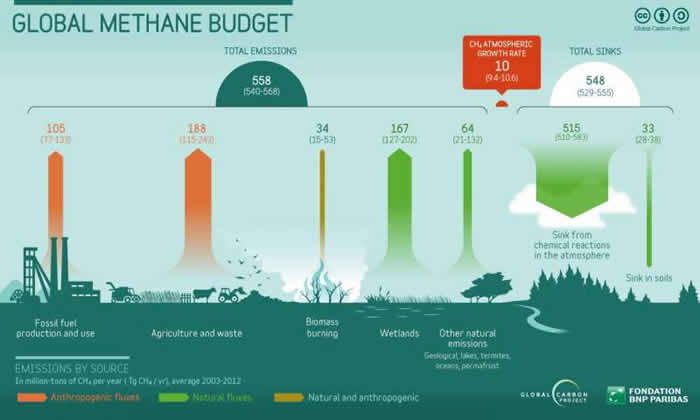Methane emissions blow away efforts to slow down climate change
The powerful greenhouse gas, and main cause of climate change, Methane, is growing faster in the atmosphere than ever before. In fact global concentrations of methane is growing faster now than at any other time in the past 20 years.
That is the message of a team of international scientists in the journal Environmental Research Letters.
The group reports that methane concentrations in the air began to surge around 2007 and grew precipitously in 2014 and 2015. In that two-year period, concentrations shot up by ten or more parts per billion annually.
It’s a stark contrast from the early 2000s when methane concentrations crept up by just 0.5 parts per billion on average each year. The reason for the spike is unclear but may come from emissions from agricultural sources and mainly around the tropics – potentially from farm sites like rice paddies and cattle pastures.
Scientists involved in the editorial will discuss these trends at a session during the fall meeting of the American Geophysical Union (AGU) in San Francisco.
The findings could give new global attention to methane – which is much less prevalent in the atmosphere than carbon dioxide but is a more potent greenhouse gas, trapping 28 times more heat. And while research shows that the growth of carbon dioxide emissions has flattened out in recent years, methane emissions seem to be soaring.
Robert Jackson, a co-author of the paper and a Professor in Earth System Science at Stanford University said: “The leveling off we’ve seen in the last three years for carbon dioxide emissions is strikingly different from the recent rapid increase in methane.”
Jackson continued: “The results for methane are worrisome but provide an immediate opportunity for mitigation that complements efforts for carbon dioxide.”
The authors of the new editorial previously helped to produce the 2016 Global Methane Budget. This report provided a comprehensive look at how methane had flowed in and out of the atmosphere from 2000 to 2012 because of human activities and other sources. It found, for example, that human emissions of the gas seemed to have increased after 2007, although it’s not clear by how much. The methane budget is published every two to three years by the Global Carbon Project, a research project of Future Earth.
Methane, Jackson said, is a difficult gas to track. In part, that’s because it can come from many different sources. Those include natural sources like marshes and other wetlands. But the bulk, or about 60%, of methane added to the atmosphere every year comes from human activities. They include farming sources like cattle operations – cows expel large quantities of methane from their specialized digestive tracks – and rice paddies – the flooded soils make good homes for microbes that produce the gas. A smaller portion of the human budget, about a third, comes from fossil fuel exploration, where methane can leak from oil and gas wells during drilling.
“Unlike carbon dioxide, where we have well described power plants, almost everything in the global methane budget is diffuse,” Jackson said. “From cows to wetlands to rice paddies, the methane cycle is harder.”
But a range of information – such as from large-scale inventories of methane emissions, measurements of methane in the air and computer models – suggests that this cycle has shifted a lot in the last two decades. It was reported that the growth of methane in the atmosphere was mostly stagnant in 2000 to 2006. But that changed after 2007.
“Why this change happened is still not well understood,” said Marielle Saunois, Lead Author of the new paper and an Assistant Professor of Université de Versailles Saint Quentin and Researcher at Laboratoire des Sciences du Climat et de l’Environnement in France. “For the last two years especially, the growth rate has been faster than for the years before. It’s really intriguing.”
Saunois added that this runaway pace could threaten international efforts to limit warming from climate change to 2°C.
Saunois said the research provides a strong argument. “We should do more about methane emissions. If we want to stay below 2° temperature increase, we should not follow this track and need to make a rapid turn-around.”
It isn’t easy to pinpointing where those methane emissions are coming from. Many environmental advocates in North America have raised concerns that expanded drilling for natural gas in recent years could lead to a surge in methane emissions. But Saunois says that based on available data, the more likely source, at least for now, is agriculture.
She and her colleagues aren’t sure what may be driving this increase. According to the Food and Agriculture Organization of the United Nations, livestock operations around the world expanded from producing 1,300 million head of cattle in 1994 to nearly 1,500 million in 2014 – with a similar increase in rice cultivation in many Asian countries.
Saunois and Jackson did argue that the story isn’t all bad news. A number of researchers have experimented with different ways of reducing methane emissions from farms.
Feeding cows a diet supplemented with linseed oil, for example, seems to reduce the amount of methane they belch out.
Jackson said: “When it comes to methane, there has been a lot of focus on the fossil fuel industry, but we need to look just as hard if not harder at agriculture. The situation certainly isn’t hopeless. It’s a real opportunity.”
More information: Phys.org


Comments are closed, but trackbacks and pingbacks are open.